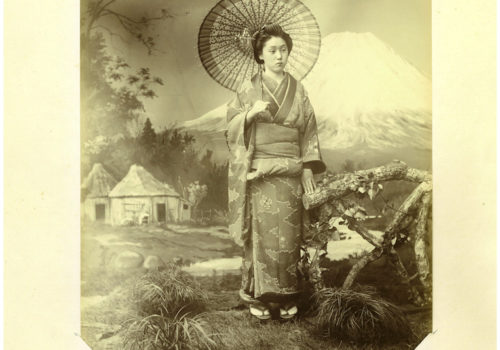THE CHRISTIAN POLAK COLLECTION
Christian Polak is a French businessman and historian of Franco-Japanese relations. Based in Japan, he has established a unique photographic collection of both historical and graphic importance. A part of these treasures was shown in the exhibition “Ishin: the dawn of scientific exchanges between France and Japan” at the Tokyo University Museum in 2009.
Kyotographie photo festival will exhibit only a small selection from his collection. They are not only exquisite photographs, but also valuable documents for researchers. An ambrotype for example, exhibited for the first time, shows soldiers and officers of the Shogun in 1868. One of them is wearing a French uniform, as part of a French military advisory mission sent by Napoleon III. The most famous of these advisors, Jules Brunet, was an inspiration for the movie “The Last Samurai”. He refused to abandon his pupils and fought alongside them in the short lived “Ezo Republic” as explained by Mr. Polak in “Soie et Lumières”. It appears that the famous photograph of Brunet,
supposedly made in Hakodate, was taken in the same studio as this ambrotype. Or could it have been taken in Edo? A new historic mystery to unravel.
Interview with Christian Polak
Can you describe your collection and its origins?
C. Polak : As an historian of Franco-Japanese relations, for 45 years I am collecting books, documents, original manuscripts, posters and I gathered a comprehensive collection of historical documents. It appeared that visual resources were precious documents to complete written sources. But old photographs were not only valuable documents for research, they have their own story and I gradually expand the scope of my collection to embrace my vision of Japanese photography.
In the history of photography is the well-known “school” leaded by, for example, Felice Beato and then Kusakabe Kimbei. A school that was able to combine artistic and technical knowledges from Japan and Europe. How difficult (or easy) is it to preserve the documentation of this union started in the past ?
C. P : Some years ago, when history of Japanese photography was at his beginning, the works of Felice Beato and Kusakabe Kimbei were the only ones readily available in the Western collections and,as the tip of an iceberg, their historical importance were overestimated. They are great artists but Beato was not so instrumental in the beginning of photography in Japan. Now, emerge the works of photographers like Ueno Hikoma, Uchida Kuichi, Shimooka Renjô, Shima Kakoku, Hori Yohei and many more. Even in the early 1870, hundreds of photographers were working in Japan. Hand-colored photography is only a part of the production and many local photographers were making ambrotypes of astonishing quality but most of this production remained kept in Japan by families. In my collection I try to embrace the whole scope of the Japanese photography of the times.
Eliseo Barbàra
京都グラフィー 国際写真フェスティバル
Kyotographie International Photography Festival
From April 13 to May 6, 2013
The Christian Polak Collection
Toraya Kyoto Gallery
Karasuma-Nishi-iru
Ichijo-dori
Kamigyo-ku
Kyoto, 603-8146
Japan
















